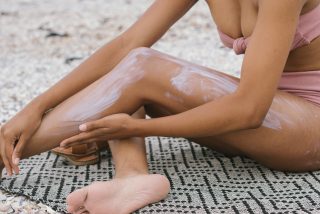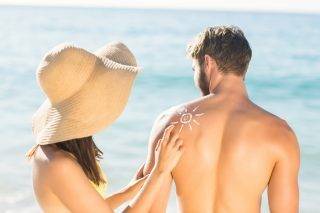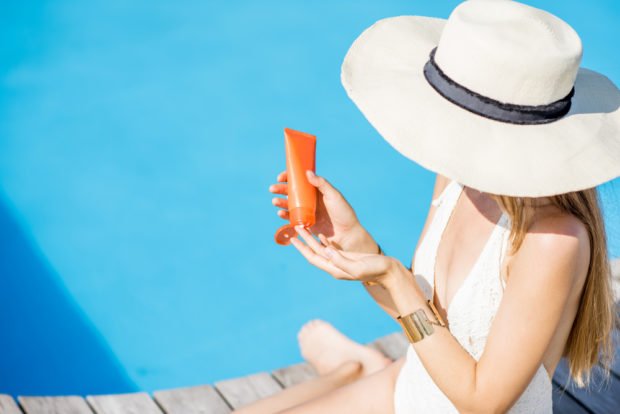Spring is in the air and that means one thing, summer is on the way! It’s a great feeling to finally be free of the cold winter but catching some rays in summer could be harmful to your health. We all love the healthy glow that a tan brings, but you could be putting yourself at risk if you aren’t wearing sunscreen while you enjoy the summer sun.
What is sunscreen

Photo by RF._.studio from Pexels
According to the Skin Cancer Foundation, it is an important part of a completely sincere protection strategy. When used correctly, it is proven to reduce your risk of developing skin cancer and helps to prevent premature aging. Fascinatingly, it dates back to ancient Egypt when rice bran extract and jasmine were used in order to aid in protecting the skin from the sun. The first commercial sunscreen, on the other hand, was invented by chemists in 1936.
Why is sunscreen so important?
Sunscreen is important for a variety of reasons. The main reason to wear it, however, is in order to prevent skin cancer. But cancer isn’t the only reason to wear sunscreen. Spending too much time in the sun, though it may be good for your vitamin D levels, can cause wrinkles and premature aging. It’s important to remember, however, that not all sunscreens are created equal. The most important part of wearing it is understanding what it is that you’re wearing and what it can or can’t do for you.
What is SPF?
Most sunscreens indicate SPF on their labels. But what on earth is SPF? SPF stands for Sun Protection Factor. It indicates the “amount of time it would take you to get a sunburn if you weren’t wearing sunscreen”. This means that it refers to the ability of that particular sunscreen to

Photo by Armin Rimoldi from Pexels
block harmful UVB rays. UVB rays are responsible for sunburns but they are the UVA rays that are the most dangerous as they are linked to sun damage. SPF does not indicate how effective sunscreen is against UVA rays. It is important to note here that both UVA and UVB rays contribute to the risk of developing skin cancer.
SPF is simply a starting point, though, according to Dr. Barney Kenet a New York-based dermatologist. Kenet notes that it’s important that people don’t get too wrapped up in the SPF number. Going from an SPF 50 to an SPF 100 for instance doesn’t double the protection. In most cases, Kenet recommends an SPF 30. He says that it’s unnecessary to use a higher SPF than that. However, he does note that SPF 30 needs to be reapplied regularly “at two- to three-hour intervals”. If you want to be protected from both UVA and UVB rays, you’ll want to choose a sunscreen that says “broad spectrum” on the label as this means “both UVA and UVB rays are blocked”
Do I have to wear it every day?
Most of us know that we should wear it when going into the sun. But sunscreen should be worn year-round. You should be wearing sunscreen even when it’s overcast and cloudy as up to 80% of the sun’s harmful UV rays pass through the clouds. Another unexpected time to use it is when it’s snowing. Snow can reflect around 80% of the UV rays which increases your risk of sun damage. It’s also important to note that the higher the altitude, the greater the exposure to the UV rays. Essentially, you need to wear it every single day no matter the weather.
It also doesn’t matter what ethnicity you are or how dark or light your skin tone is, sunscreen is for everyone. The Skin Cancer Foundation recommends that all men, women, and children over the age of 6 months should use sunscreen on a daily basis. An important thing to remember is that it actually doesn’t matter whether or not you burn after sun exposure. Sun damage happens over time and tanning easily or not burning doesn’t mean that you’re safe from sun damage. Babies under the age of 6 months are the only exception. They should be kept out of the sun entirely and sunscreen should not be used as their skin is just too sensitive.
What type of sunscreen should I use?
 The Skin Cancer Foundation recommends using a sunscreen that is broad-spectrum and with an SPF of 15 or more. There are two main types of sunscreen: physical or mineral sunscreens and chemical sunscreens.
The Skin Cancer Foundation recommends using a sunscreen that is broad-spectrum and with an SPF of 15 or more. There are two main types of sunscreen: physical or mineral sunscreens and chemical sunscreens.
Physical/Mineral: This type of sunscreen blocks and scatters the sun’s rays before they can penetrate the skin. They usually contain ingredients like titanium dioxide and zinc oxide. They are generally thought to be the safer option for more sensitive skin types as they are, in most cases at least, less likely than their chemical counterparts to cause surface irritation.
Chemical: This type of sunscreen absorbs the UV rays before they can penetrate and damage the skin. They usually contain ingredients like avobenzone and octisalate. They are generally thought to be a great option for all skin types, though people with very sensitive skin types may fare better with a physical or mineral sunscreen.
It’s important to point out that all the active ingredients are at least chemically derived. Physical sunscreens are generally thought to be more natural, and some people may even refer to them as “organic.” However, they’re actually inorganic mineral compounds. Chemical sunscreens are “UV organic filters”.
Are there any dangers associated with sunscreen?
Some research has found that certain ingredients in sunscreens may be problematic as they are absorbed into the body over time. Sunscreens, as they are currently, were approved under an older testing standard. The only ingredients that meet the current FDA GRASE (Generally recognized as safe and effective) standards are titanium dioxide and zinc oxide.
currently, were approved under an older testing standard. The only ingredients that meet the current FDA GRASE (Generally recognized as safe and effective) standards are titanium dioxide and zinc oxide.
The FDA has requested that manufacturers submit information on the safety and effectiveness of the following ingredients: If you are worried about toxicity, it may be best to avoid these ingredients until they are FDA certified.
- Ensulizole
- Octisalate
- Octocrylene
- Octinoxate
- Avobenzone
- Cinoxate
- Dioxybenzone
- Meradimate
- Sulisobenzone.
Sun protection is important, which is why it is imperative that we adopt regular use of sunscreen in our lives. However, with Hawaii banning oxybenzone this past year, one has to wonder which other toxic chemicals may be lingering in our sunscreens.
Watch out for oxybenzone!
While it is advisable to use sunscreen, a lot of these products contain ingredients that may have adverse effects on the body. Oxybenzone, for one, has been found to cause hormonal disruption, cell damage, allergies, and even jeopardize coral reefs, which can then affect biodiversity.
Oxybenzone has also been cited in extensive research that shows this chemical is destroying coral reefs in key ocean areas. Indeed, lobbyists have ensured products with oxybenzone will be banned from sales in this state. These products have been shown to be destroying coral reefs in Hawaii, so important for ocean ecology as well as tourism.
According to The Center for Biological Diversity, sunscreens containing two harmful petrochemicals, avobenzone and octocrylene, would be banned from sale in Hawaii under a bill passed today by the Hawaii Senate.
The bill follows a 2018 law banning oxybenzone and octinoxate sunscreen. Studies show that all four of these petrochemical sunscreens are toxic to human health, coral reefs, and marine species.
“This is great news for our imperiled coral reefs and marine life,” said Maxx Phillips, Hawaii’s director and staff attorney at the Center for Biological Diversity. “People can protect their skin without harmful petrochemicals while Hawaii protects public and environmental health.”
The Center has petitioned the U.S. Food and Drug Administration for a national ban on coral-killing chemicals in sunscreens.
Research demonstrates that octocrylene can disrupt human hormones and have toxic impacts on a variety of aquatic organisms, including corals, fish, and marine mammals. A soon-to-be-published study shows that octocrylene degrades into benzophenone, a powerful carcinogen, reproductive disruptor, and herbicide.
Avobenzone is also an endocrine disruptor and can reduce coral resilience against the high ocean temperatures that are killing corals worldwide through global warming.
“Studies show fish exposed to octocrylene exhibited endocrine disruption, brain deformities in larvae, and reproductive toxicity,” said ecotoxicologist Craig Downs. “Because octocrylene bioaccumulates, what does that mean for people eating these fish, especially pregnant women and keiki? Avobenzone may cause dysfunction with the powerhouse of the cell, which may kill cells and induce a bleaching effect in corals.”
Others to watch out for
Like oxybenzone, the ingredients listed below can be found in sunscreens – but you definitely don’t want them on your skin.
6 More Toxic Ingredients in Sunscreen
1. Avobenzone
Sunscreens contain avobenzone because of how well it absorbs UVA rays – the ones responsible for sunburn. While it is a relatively safe ingredient, avobenzone is not a very stable one.
As it lacks stability, the avobenzone breaks down when exposed to the sun for longer than 30 minutes. It then degrades into unknown chemicals, releasing free radicals. As we know, free radicals are directly responsible for accelerating skin aging and increasing the risk of cancer.

Aside from sun exposure, a study published in the journal Chemosphere, found that when exposed to chlorine, avobenzone can turn toxic and jeopardize the health of both the kidney, liver, and nervous system.
2. Homosalate
Homosalate absorbs UVB rays, the same rays that increase the risk of skin cancer.
Unfortunately, homosalate accumulates in the body faster than the body can detoxify it through the liver. It then lingers in the body, becoming toxic and disrupting hormonal balance, with one study revealing how homosalate encouraged the multiplication of human breast cancer cells.
3. Parabens
Parabens are preservatives found in many beauty products. However, studies have linked parabens to a number of health issues. These include infertility, breast cancer, uterine tumors, obesity, asthma, and allergies.
The effects of parabens are so severe that in 2014, the EU banned five common types of parabens.
4. Octinoxate
Manufacturers combine octinoxate with avobenzone to help the avobenzone work longer. Octinoxate also protects the skin against UVB rays.

However, octinoxate has been linked to disrupting hormonal activity, so much so that it affects both the reproductive system and thyroid. Furthermore, like avobenzone, when exposed to sunlight octinoxate breaks down and produces free radicals.
Lastly, like oxybenzone, octinoxate has been targeted in Hawaii’s ban in a bid to protect coral reefs.
5. Octocrylene
Like octinoxate, manufacturers combine octocrylene with avobenzone to help avobenzone work longer. Octocrylene is also used because of how well it absorbs UVB and UVA rays.
However, octocrylene can pierce quite deep into the skin, where it then encourages the production of free radicals. In fact, a study published in the journal Free Radical Biology & Medicine revealed how, when left on the skin for an hour, octocrylene, octinoxate, and oxybenzone increased the production of free radicals, with the levels of production being quite high.
6. Retinyl palmitat
Retinyl palmitate is an antioxidant and a derivative of vitamin A. It helps to protect the skin against premature aging.
Unfortunately, studies have shown that retinyl palmitate quickens the development of malignant cells and skin tumors as a result of UV rays breaking the ingredient down.
Tips for safer sunscreens
When choosing a sunscreen, it’s best to go for one made from natural materials. Such materials include zinc oxide, mexoryl sx, and titanium dioxide.
With regards to titanium dioxide, stay clear of this ingredient in aerosol spray sunscreen. While safe in lotion form, it can become quite toxic when inhaled.
The takeaway
Despite some worries regarding ingredients, wearing sunscreen is still heavily recommended by doctors and dermatologists alike as the benefits far outweigh the possible negatives. Remember to wear sunscreen every single day. If you are worried about toxicity, try to find a sunscreen that contains titanium dioxide and zinc oxide rather than any other chemical ingredients. Make sure you follow the instructions on the bottle and you should have a great, skin damage-free summer!
References
https://www.skincancer.org/skin-cancer-prevention/sun-protection/sunscreen/
https://ehe.health/blog/always-wear-sunscreen/
https://biologicaldiversity.org/w/news/press-releases/hawaii-senate-bill-bans-harmful-sunscreen-chemicals-2021-03-09/





![women [longevity live]](https://longevitylive.com/wp-content/uploads/2020/01/photo-of-women-walking-down-the-street-1116984-100x100.jpg)









